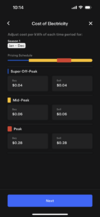What parameters are reasonable to enter into settings for buy/sell behavior?
I’m not necessarily looking to maximize return but rather avoid blocking buy/sell with matching amounts for buy/sell.
Image shows current setting: my TOU rates, and my buy/sell parameters, all match.
Is this a reasonable setup?
Or am I canceling out any buy/sell by making it match?
I’m not necessarily looking to maximize return but rather avoid blocking buy/sell with matching amounts for buy/sell.
Image shows current setting: my TOU rates, and my buy/sell parameters, all match.
Is this a reasonable setup?
Or am I canceling out any buy/sell by making it match?



